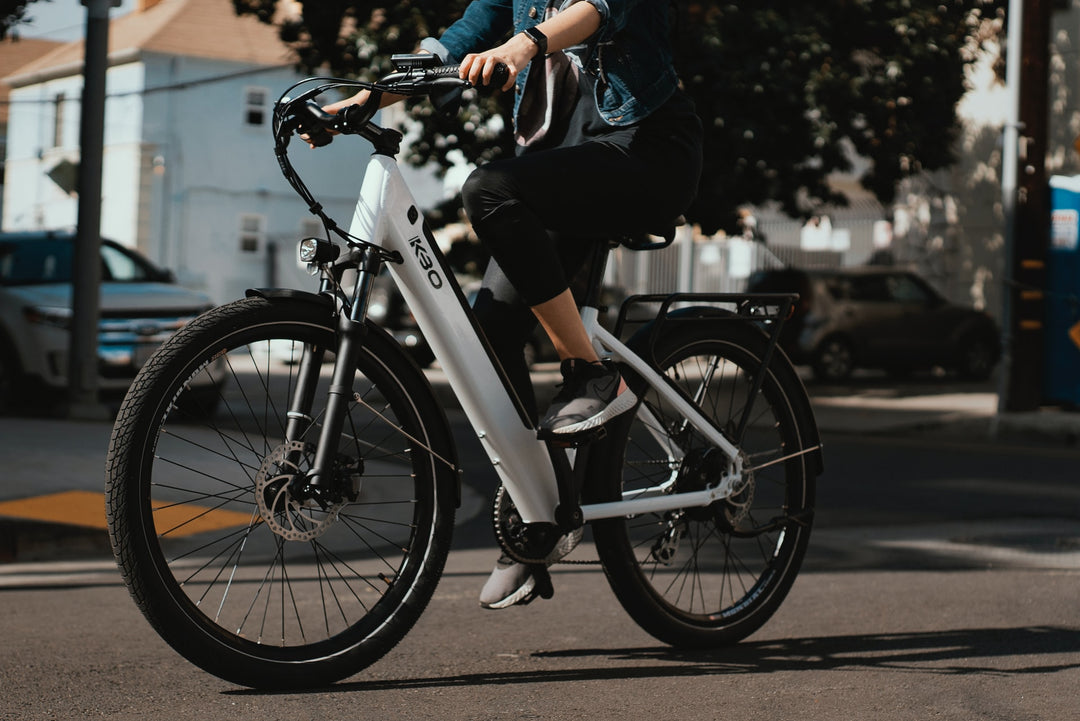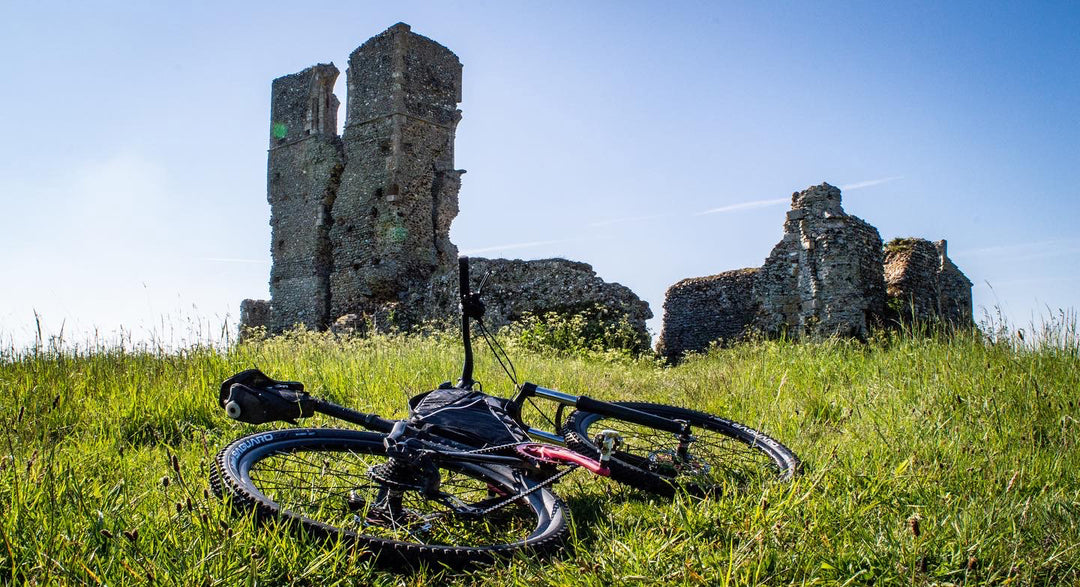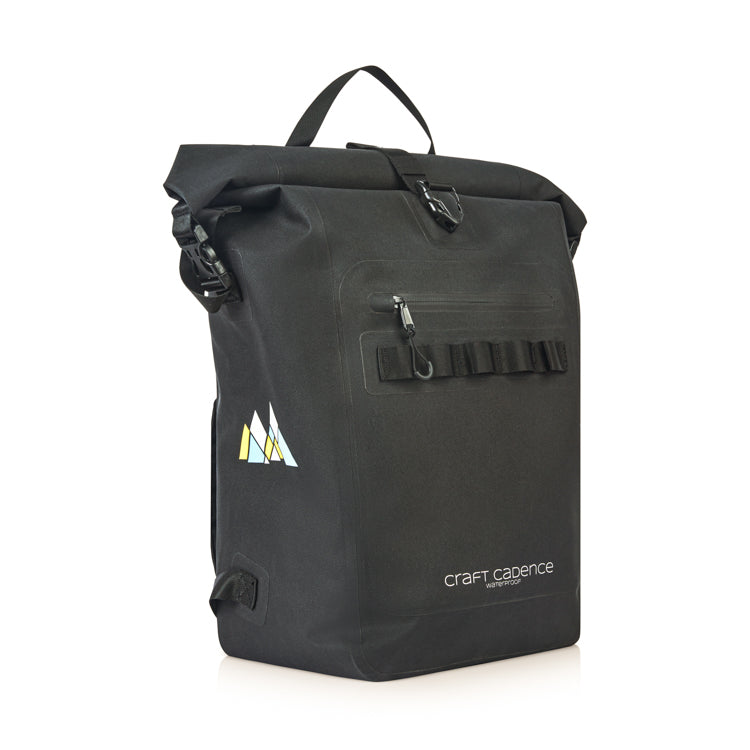Creating an eco-friendly waterproof cycling backpack series - market research - EP003
Before diving deep into manufacturing our own bags, we wanted to see who else manufactured backpacks from rPET and whether they had any success in their particular market - just to give us an understanding of we may be able to expect down the line.
From our research, it seems that rPET is not only a niche material used in backpacks, it is almost non existent, especially in the cycling industry.
However, here are a few examples that we found.
Vaude is a famous brand in the cycling baggage space and we are real admirers of this company for their professionalism, quality products and their approach to environmental sustainability. The PETair is an everyday backpack made from used textiles, PET bottles and Vaude claims that the bag saves up to 50% energy in the manufacturing process, 100% fossil fuels, and 50% CO2 emissions.

The bag looks quality as you would expect from Vaude. The design is clean and minimalist, while retaining important functions such as double compartments, side pockets for bottles and a laptop section.
What I notice about the bag is the price, at £120 pounds it is a very steep price to pay for what looks to be a very conventional 'jack of all trades' backpack. It does not have any spectacular features and it is hard to see exactly what you are paying the premium for other than the eco-friendly badge. We suspect that this bag is a niche product and would not feature as one of Vaude's best selling backpacks. It does not appear to be 100% waterproof as the bag is sewn and there are zippers going around the top of the bag.
It does prove however that it is very much possible to develop a rPET bag that looks high quality and one that most consumers probably cannot tell apart from conventional bags.
This is another beautiful looking rPET backpack from Crumpler, retailing at £129. Again, this is not a cycling specific backpack and is aimed more towards the urban professional. It also has a clean, neat design and made in the tote style. It has a carry handle and a sleeve for a 15.6 inch laptop. It is made from 100% recycled polyester.

For the cycle commuter the weaknesses of the bag are that it is not 100% waterproof and there is a lack of padding at the back of the bag for wicking away moisture while riding. The bag also does not look to be rough and rugged enough to withstand the elements over the course of a number of years on the road.
Ergobag is a German company specialising in bags for children and teenagers from kindergarten to secondary school. We were very impressed with their branding, ethos and their overall communication strategy. Their website is friendly, welcoming, and the type that makes you want to scroll on and on and find out more.
All of their bags are made with 100% recycled PET fabrics and they've created a page detailing this process.
They do seems to be thriving commercially, judging from their large range of products, availability of their site in multiple languages to support diverse markets and the number of people in their team. Their bags are not cheap at all - the flagship Ergobag comes in at a whopping EUR239. As a parent myself it would be difficult to justify spending this considering competing priorities - but for families with multiple children where the bag will be used for a long time, it could make sense.

What we take from Ergobag is that environmentally friendly bags made from rPET can be commercially successful if marketed correctly and placed in the premium segment of the market. If you observe Ergobag's strategy, their selling point is primarily the ergonomic design of their bags, which is inspired by the design and principles of trekking backpacks to minimise the impact of weight on children's backs. The fact that the bag is also sustainable is almost a cherry on the cake. Which is to say that for eco-friendly bags to be successful, they first have to solve the pain point of the customer - which in this case is the worry that children will suffer back pain from a poorly designed backpack. The environmental aspect can be seen as the emotional factor that closes the deal.
This is a key lesson that we will need to apply in our own rPET backpack. The unique selling point should not be the fact that the backpack is environmentally friendly, but something else that solves the customers problems. It will also not be wise to market the bag primarily as a eco-friendly bag, as that risks the product being pigeon holed into a small niche segment while the product has the potential to serve a larger mass market.
This backpack is made from Lefrik, a Spanish based company that we have not heard of.
Again, the bag has a simple, clean and minimalist design. It also has a roll top which aides waterproofing. There is a side pocket at the back of the bag for small essentials and a laptop sleeve inside. Other than that, there is not too much more to say.

The bag is made fro 100% recycled PET bottles and what was particularly surprising about this bag is the price point at EUR59.90, which is by far the cheapest rPET bag that we found in our market research. We were immediately curious about how they are able to manufacturer at such a low price point, whether they manufacture locally in Spain or in the Far East, and whether there was something distinctive in their supply chain. It does appear that their bags do not have the usual "bells and whistles" of a typical urban backpack, which could save costs. There is no padding at the back pf the bag, no foam based materials (e.g. EVA) on the shoulder straps to cushion the weight of the bag against the shoulder, and the shoulder straps themselves look quite basic.
Commercially, Lefrik looks to be doing well. It has five categories of products ranging from backpacks, laptop sleeves and apparel and ships worldwide. It even has its own brick and mortar shopfront in Spain, Madrid and have dozens of resellers in Spain and Portugal.
This is a company and a bag that we will keep a close eye to learn from their experience.
From our cursory desk based market research, it seems like the following observations can be made about rPET backpacks in general.
All of which makes this project to produce a rPET cycling commuter backpack all the more challenging. There will likely be technical challenges to ensure waterproofing, as we aim to achieve at least IPX5 waterproof rating on all our bags. There will be challenges to keep costs down as the rPET fabric is likely to be much more expensive than conventional materials such as nylon, polyester and PVC. Finally, finding a supplier of rPET materials that produces rPET fabric to the same quality as conventional material will not be an easy task.
What we do take note however, are some keys to success, gleaned from the case studies we have seen so far:
Let us know what you think of the market research we have done and if you agree. Do you think a more environmentally friendly rPET backpack for cycle commuters has legs? All comments welcome.
From our research, it seems that rPET is not only a niche material used in backpacks, it is almost non existent, especially in the cycling industry.
However, here are a few examples that we found.
Vaude PETair
Vaude is a famous brand in the cycling baggage space and we are real admirers of this company for their professionalism, quality products and their approach to environmental sustainability. The PETair is an everyday backpack made from used textiles, PET bottles and Vaude claims that the bag saves up to 50% energy in the manufacturing process, 100% fossil fuels, and 50% CO2 emissions.

The bag looks quality as you would expect from Vaude. The design is clean and minimalist, while retaining important functions such as double compartments, side pockets for bottles and a laptop section.
What I notice about the bag is the price, at £120 pounds it is a very steep price to pay for what looks to be a very conventional 'jack of all trades' backpack. It does not have any spectacular features and it is hard to see exactly what you are paying the premium for other than the eco-friendly badge. We suspect that this bag is a niche product and would not feature as one of Vaude's best selling backpacks. It does not appear to be 100% waterproof as the bag is sewn and there are zippers going around the top of the bag.
It does prove however that it is very much possible to develop a rPET bag that looks high quality and one that most consumers probably cannot tell apart from conventional bags.
Crumpler The Algorithm
This is another beautiful looking rPET backpack from Crumpler, retailing at £129. Again, this is not a cycling specific backpack and is aimed more towards the urban professional. It also has a clean, neat design and made in the tote style. It has a carry handle and a sleeve for a 15.6 inch laptop. It is made from 100% recycled polyester.

For the cycle commuter the weaknesses of the bag are that it is not 100% waterproof and there is a lack of padding at the back of the bag for wicking away moisture while riding. The bag also does not look to be rough and rugged enough to withstand the elements over the course of a number of years on the road.
Ergobag
Ergobag is a German company specialising in bags for children and teenagers from kindergarten to secondary school. We were very impressed with their branding, ethos and their overall communication strategy. Their website is friendly, welcoming, and the type that makes you want to scroll on and on and find out more.
All of their bags are made with 100% recycled PET fabrics and they've created a page detailing this process.
They do seems to be thriving commercially, judging from their large range of products, availability of their site in multiple languages to support diverse markets and the number of people in their team. Their bags are not cheap at all - the flagship Ergobag comes in at a whopping EUR239. As a parent myself it would be difficult to justify spending this considering competing priorities - but for families with multiple children where the bag will be used for a long time, it could make sense.

What we take from Ergobag is that environmentally friendly bags made from rPET can be commercially successful if marketed correctly and placed in the premium segment of the market. If you observe Ergobag's strategy, their selling point is primarily the ergonomic design of their bags, which is inspired by the design and principles of trekking backpacks to minimise the impact of weight on children's backs. The fact that the bag is also sustainable is almost a cherry on the cake. Which is to say that for eco-friendly bags to be successful, they first have to solve the pain point of the customer - which in this case is the worry that children will suffer back pain from a poorly designed backpack. The environmental aspect can be seen as the emotional factor that closes the deal.
This is a key lesson that we will need to apply in our own rPET backpack. The unique selling point should not be the fact that the backpack is environmentally friendly, but something else that solves the customers problems. It will also not be wise to market the bag primarily as a eco-friendly bag, as that risks the product being pigeon holed into a small niche segment while the product has the potential to serve a larger mass market.
Lefrik Eco Roll Backpack
This backpack is made from Lefrik, a Spanish based company that we have not heard of.
Again, the bag has a simple, clean and minimalist design. It also has a roll top which aides waterproofing. There is a side pocket at the back of the bag for small essentials and a laptop sleeve inside. Other than that, there is not too much more to say.

The bag is made fro 100% recycled PET bottles and what was particularly surprising about this bag is the price point at EUR59.90, which is by far the cheapest rPET bag that we found in our market research. We were immediately curious about how they are able to manufacturer at such a low price point, whether they manufacture locally in Spain or in the Far East, and whether there was something distinctive in their supply chain. It does appear that their bags do not have the usual "bells and whistles" of a typical urban backpack, which could save costs. There is no padding at the back pf the bag, no foam based materials (e.g. EVA) on the shoulder straps to cushion the weight of the bag against the shoulder, and the shoulder straps themselves look quite basic.
Commercially, Lefrik looks to be doing well. It has five categories of products ranging from backpacks, laptop sleeves and apparel and ships worldwide. It even has its own brick and mortar shopfront in Spain, Madrid and have dozens of resellers in Spain and Portugal.
This is a company and a bag that we will keep a close eye to learn from their experience.
Lessons Learnt
From our cursory desk based market research, it seems like the following observations can be made about rPET backpacks in general.
- rPET bags rare and hard to find for the normal consumer
- Only a handful of well known companies in the world make rPET backpacks
- There is no 100% waterproof backpack in the market in the world, especially one geared towards the cycling audience. If we pull it off we will be the first company in the world to make a 100% waterproof backpack from rPET.
- rPET made bags are usually expensive, upwards of $120
- rPET bags usually follow a simple, minimalist design, most likely to reduce the use of virgin materials for the back panel and shoulder straps, as well as compartments on the inside
All of which makes this project to produce a rPET cycling commuter backpack all the more challenging. There will likely be technical challenges to ensure waterproofing, as we aim to achieve at least IPX5 waterproof rating on all our bags. There will be challenges to keep costs down as the rPET fabric is likely to be much more expensive than conventional materials such as nylon, polyester and PVC. Finally, finding a supplier of rPET materials that produces rPET fabric to the same quality as conventional material will not be an easy task.
What we do take note however, are some keys to success, gleaned from the case studies we have seen so far:
- The backpack needs to appeal to our core audience of cycle commuters, and not the "eco-warrior" audience because they are less likely to be cycle commuters and arguably there are less "eco-warriors" compared to cycle commuters (sad but true)
- The backpack needs to have an unique selling point other than the fact that it is made from more environmentally friendly materials.
- Following from point 2, the backpack should not be marketed primarily as a eco-friendly backpack. The fact that it is more environmentally friendly should be seen as a bonus, not the main reason for purchase
Let us know what you think of the market research we have done and if you agree. Do you think a more environmentally friendly rPET backpack for cycle commuters has legs? All comments welcome.



